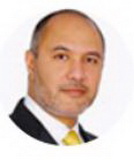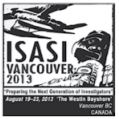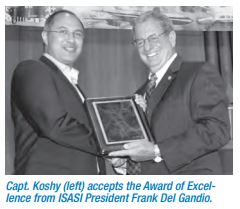

 ISASI 46
ISASI 46
Capt. Ibrahim S. Koshy is the director general of the Aviation Investigation Bureau (AIB) (AT TIME OF ORIGINAL PUBLICATION) of the Kingdom of Saudi Arabia, a member of the board of the newly established MENASASI Chapter. He is an IOSA senior lead auditor and evaluator with more than 25 years as an airline pilot with experience in E170, G-IV, B-737, A300-600, B-777, and A330 types. He has served in various management positions in airline flight operations safety and corporate safety. He is a graduate in aeronautical science (aviation safety and accident investigation) from ERAU in the United States and is working on an MSc in safety and accident investigation at Cranfield University in the United Kingdom.
Like the majority of the International Civil Aviation Organization (ICAO) signatory states, the Kingdom of Saudi Arabia assigned the authority and responsibility of investigating aviation occurrences to the regulator, the General Authority of Civil Aviation (GACA).
To be in line with ICAO standards and recommended practices, a decision was made in 2009 to transfer the authority for aviation occurrence investigation to an agency independent from the regulator; this was the impetus for the birth of the Aviation Investigation Bureau (AIB).
Many actions took place before the AIB was born, including the senior government decision in the form of a royal decree for the establishment of an independent aviation occurrence investigative agency, the regulator (the GACA) amending articles of the Civil Aviation Act transferring the authorities from the regulator, and the GACA making internal amendments by resolutions. In 2012, Capt. Ibrahim S. Koshy was tasked to establish and head the AIB and was appointed as its first director general. A very important first step was the establishment of the AIB regulation.
The AIB regulation was required to define the authorities officially for operators, service providers, pilots, air traffic controllers, airports, and other regulators to understand who the AIB was and to understand the authorities of the AIB. The AIB regulation was approved in January 2013 and became effective in November 2013.
Challenges
Getting the right people on board in any startup, including a government agency, is very important. Not only do they have to know how to do it right, but they have to know how to build it. In addition to investigating occurrences, the team being put together would be responsible for building a system, policies, procedures, and processes.
The first person brought on board was Serge Lemire, who had years of experience as an investigator with the Transportation Safety Board (TSB) of Canada. Lemire was also familiar with aviation in Saudi Arabia, as he had been assigned to GACA aviation safety through ICAO. Lemire was brought on board as the first AIB director of investigations, and bringing other investigators on board created a core team that could conduct occurrence investigation in a professional manner.
Having a team “look inside” and “tend the house” allowed the director general to “look outside” and determine required regulatory changes, determine desired capabilities, determine a long-term strategy, and define an organizational structure that would be effective for the current situation as well as fit in with the projected level of aviation activity in the kingdom.
Many tasks were required, including getting an approved organizational structure, getting job descriptions and authorities for each position, applying for a budget, getting financial authorities for the office and staff, getting a budget for the desired lab facilities, getting vehicles and equipment, and most importantly a temporary facility as well as an approval for a permanent facility that would be the home of the AIB. In the first year, the office walls were covered with many project charts that were being run simultaneously. There were many late nights at the office as well as working outside of the office during the first year.
Actual levels of independence and priorities
Although independence was very important, it was also important to decide how to achieve the appropriate levels of independence that would serve the interest of the AIB. The strategy looked at three areas in detail: functional independence, administrative independence, and financial independence.
A five-year strategy was set by the AIB in which 100% functional independence was required from day one. In relation to financial and administrative independence, however, it was decided by the AIB that in order to concentrate efforts in building the desired investigative and lab capabilities, the AIB would utilize financial and administrative support that was available initially from the GACA while the AIB gradually built its own financial and administrative department in accordance with the government’s requirements. This was still considered by the AIB to have a level of independence as the administrative authority resided with the AIB while the execution of administrative functions would be with another government agency (the GACA). The AIB strategy calls for developing its own financial and administrative capabilities in 2018.
Working together—investigative authorities
While building an organization, it’s not enough to just do it the way you think it should be done; you need to get out there and see how others are doing business. Take time to visit others who have been in this business for a while.
A lesson learned is “Don’t isolate yourself. To be effective, you need to go out and work with others locally, regionally, and internationally.”
The AIB had a familiarization project that entailed visiting various investigative authorities. From 2013 through 2015, the project entailed visits to the the AAIB–UK, the BEA–France, the TSB–Canada, the ATSB– Australia, the NTSB–U.S.A., and the BFU– Germany. Sitting down to hear what worked for the various agencies as well as what didn’t work helped the AIB in deciding several changes to what its organizational structure should look like.
The visits also let the AIB better understand the processes they used to stay on top of things, which gave us additional insight into some capabilities that we felt should be established in our ops room design as well as in our recorder labs. There are a large number of international carriers overflying Saudi Arabia due to the size and geographical location of the state as well as the political developments and economic and aviation growth in the region. The reachout to other safety boards helped the AIB build a good rapport quite fast.
Working together—regional cooperation
Reaching out and coordinating with our regional counterparts has been very beneficial for the AIB. States like the United Arab Emirates (UAE) have taken initiatives and reached out to bring other investigative authorities in the region together in a way that has helped the investigative authorities in the region better understand each other’s capabilities.
This has allowed the AIB to better understand what capabilities and resources to invest in. The initiatives by the UAE have also improved regional coordination in training by offering seats to states. This is now being reciprocated by other states in the region, including the AIB of Saudi Arabia.
The lead initiative by the UAE in establishing a local ISASI chapter for the Middle East and North Africa (MENASASI) has brought aviation safety professionals and investigators together on a regular basis in another forum to discuss current issues and improve cooperation and understanding of current issues among safety investigators.
Working together—Saudi Arabia
The theme of ISASI 2015 was “Independence Does Not Mean Isolation,” and the realization of how closely the AIB found it was required to work with the GACA to be effective is a perfect example of how the investigative authority and the regulative authority cannot work in isolation if they are to be effective.
One of the main challenges the AIB initially faced was in spite of press releases and circulars issued to the operators, service providers, and the aviation community, there was a problem with notifications and awareness of who the AIB was. Coordination with the GACA through frequent reminders on the new requirements and reachout programs at 28 airports in the country with all stakeholders—including airlines, service providers, airport management, air traffic control, fire rescue services, civil defense, police, airport security, customs, etc.—raised the awareness level of who the AIB was, and the notifications situation improved considerably. The concept of first responders, which appeared to be working well for the BEA of France, was appealing to the AIB. Working with the GACA, the AIB created its own “first responders” by utilizing safety and quality personnel at each airport who were briefed and trained in the requirements of the AIB in the event of an occurrence until the AIB arrived on site. Furthermore, the AIB now participates in all airport emergency drills to give its input in regards to preservation of evidence and investigative requirements and to continue the reach out.
The GACA had previously developed a software database for occurrence tracking that the AIB now utilizes for its own occurrence tracking. Establishing memorandums of understanding (MOUs) with other agencies that an investigative authority requires to coordinate with in an accident investigation is an important task. The GACA previously had entered into MOUs with agencies, and utilizing those MOUs, rather than starting from scratch, as a basis for some of the AIB’s required MOUs was quite helpful. There are many MOUs that still require updating, including those between GACA and the AIB. The importance of MOUs cannot be underestimated.
Working together—coast guard, research institutes, and universities
Getting to know what capabilities were available in the country that the AIB might require in the course of an investigation was necessary. The AIB reached out to universities, colleges, and research centers and found the following capabilities:
- Supercomputers—which with data could be used for predicting wreckage scatter patterns in the event of a mid-air collision or an explosion in flight (like the Lockerbie event). This capability was also found to be beneficial to assist in locating underwater wreckage by using sea current data and mathematical formulas. These supercomputers could also be used in safety studies for visualization of airway and an analysis in visualization labs (the cave).
- Material and fluid analysis—the AIB also identified other capabilities in the country where material and fluid analysis was available and to what standards the labs were being operated. This allowed the AIB to identify areas where it could either use the facilities or would have to develop its own in-house capability. A strategic partnership is in the making with a European world-class certification and inspection company for bringing material-analysis capabilities and competency, including technology and skills transfer.
- Marine search and recovery—In reaching out to the faculty of marine science in Jeddah, we found that it had projects like mapping the floor of the Red Sea and studying sea currents and that it had some of the most-advanced equipment and teams available in the field that could be utilized in the event of an aviation occurrence in our waters to help locate wreckage.
We reached out to the Coast Guard to come to an understanding on roles in wreckage recovery. We also realized that the experience and capabilities to locate recorders wasn’t adequate and would have to be built. The AIB plan to build the experience and capabilities to locate recorders begins in late 2015, with the first exercises expected to be conducted in 2016. A lesson learned is “Don’t isolate yourself. To be effective, you need to go out and work with others locally, regionally, and internationally.”
WRITTEN BY: Capt. Ibrahim S. Koshy, director general of the Aviation Investigation Bureau (AIB) of the Kingdom of Saudi Arabia (at time of original publication)
PUBLISHED ON: THE ISASI FORUM MAGAZINE,Volume 48, Number 4 – October-December 2015
| This paper received the Best of Conference Award of Excellence for technical papers presented at ISASI 2015.
|
 |

